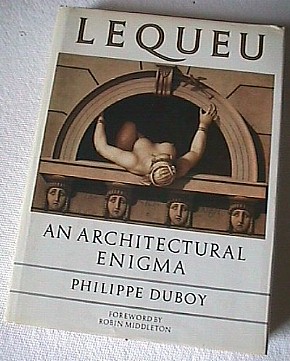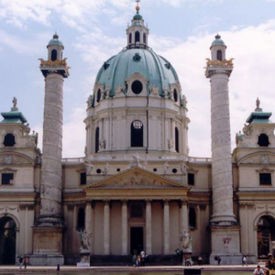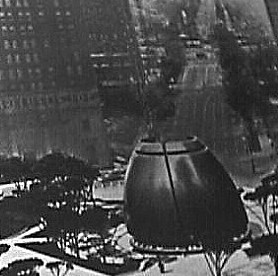Changing Out of a Dress
...The objective gaze is only an invention, an invention that withdraws the body in the hopes of establishing a conventional image of a body, of how the body should be seen. The body is re-marked.
It is a gaze that turns the body into a machine, into mechanical parts, reducing the body to machine, to architecture, (ex)posing the body as architecture.…
...Lequeu's drawings that reveal the human body in architecture and architecture in the human body (ex)pose the potential threat of a gaze that would simply order the body into regions to be known and observed, a body that may be policed, controlled, which may be easily read, a body that loses nothing and lacks nothing. The threat is a possible removal of the body through the use of the gaze, or rather a removal that presupposes that there is a body in the first place, a nostalgic myth of an (im)possible access to the real through the body, a withdrawal of the body that Lequeu is addressing and un-dressing by turning towards the sexual organs, imitating a certain ordering and organizing of these organs, imitating a certain distancing, the claim for an objective site/sight, and yet un-dressing this site/sight as incapable of reducing the body, of producing a body of knowledge that isn't the invention of a false sight/site, a site/sight of blindness, blind to the other, blind to the body, having to look away from the body, in order to know/no the body, negate the body in the name of science and knowledge.
Lequeu un-dresses this gaze as caught up in a violent desire to possess the body, a desire structured around lack, focusing on how such a gaze results in the loss of the body, a loss that has always already occurred, returning this gaze to the origin of drawing, an origin caught up in desire and loss, an imaginary loss of something that wasn't there, staging the aftermath of desire, of the conversion of the body in his drawing One of the plain façades of the Menagerie of that most deserted spot, known as the place of transformations. Here Lequeu's marginalia takes up the themes and stories of Ovid's Metamorphosis, revealing the site/sight of desire's aftermath, a site/sight of the body's loss, a confrontation with the loss of the body. Lequeu writes "here the Propetides and Echo were metamorphosed into Rocks and bound together." Lequeu lists a series of other characters who were transformed, transformed by and through desire: Adonis, Narcissus, Olene, Atys, Pithys, Crocus, Cissus, Sycee, Argus, among others. Lequeu marks these transformations, these instances of the removal of the body as being located now in the most deserted spot, a spot without body, a spot of exile from the body, an exile caused by desire, by a desire unrequited, by lack, by a refusal of an assimilating gaze, a possessive gaze, a gaze that leads to the withdrawal of the body, a gaze that is caught up in the origin of drawing.
Lequeu will implicate architecture in such a sight/site of desire, inscribing architecture's role in a scene of desire, specifically studying the labyrinth, a form that Lequeu not only shows an interest in within his drawings, his use of trap doors and secret passageways, but also in his means of organization, his cross-referencing, the labyrinthine quality to his œuvre.1 Lequeu, however, directly, frankly, raises the question of the labyrinth, or at least as directly as Lequeu ever does, in his drawing Tomb of Porsenna, a drawing that cites Pliny, but also digresses to give a history of the Labyrinth from Egypt to Crete to Lemnos to Etruria. Here Lequeu mentions the Minotaur the offspring of Pasiphae's copulation with a bull, a copulation aided by the architect Daedalus who constructed a life-like hollow cow (and Lequeu's "life-like" Cow Byre, Venturi's Duck House avant la lettre, should not be far from mind), Daedalus the architect of the labyrinth of Crete, who constructed the space of desire and desire's entrapment, Daedalus, as Lequeu mentions, who with his son Icarus tried to escape through flight, through constructed wings from this scene of desire.
| |
Lequeu, inheritor from Daedalus, ties architecture back to desire, back to the body, the body which has been withdrawn, drawn away, taken away, the body which is lost to desire, a body lost in desire, a desire structured around the body's lack, lost in the origin of drawing, lost to drawing. Lequeu somehow wants to return, recover this body, a physical body that is withdrawn in a new objectivity, but a body that is also lost at and in the origin of drawing, a body that is lost through the pursuits of desire, and in the pursuit of desire, a body whose loss is the very basis of desire. "The function of desire must remain in a fundamental relation with death." Lequeu focuses on a space where the body has been withdrawn, but he focuses on such spaces only in an attempt to un-dress the body's materiality, to strip it bare, to (ex)pose it, and through this (ex)posure to reveal the body's loss always already at the origin. He is trying to find a space where a body might exist, but this existence is cut across by a desirous gaze, by the gaze of the other, by a gaze that disrupts and contests bodily control, placing the body at constant risk of assimilation, elimination, of being set out in a desert, deserted, entrapped within a labyrinth, prisoner to desire, and prisoner due to desire....
1 I would also suggets Lequeu's method of hiding notes behind drawings, of inserting newspaper articles between drawings, of using flaps in his drawings to conceal differing versions of the same drawing, as a process of organization that incorporates a labyrinthine quality of trap doors and secret passage ways within the organization of Lequeu's ceuvre.
Kevin Malcolm Richards, Negotiations Towards a Self, 1770-1830 (dissertation, Bryn Mawr College,1995).
2004.11.10 12:32
Re: Concrete Comedy: A Primer
Anybody else here ever read Lequeu: An Architectural Enigma by Philippe Duboy?
"...with meticulous research to decipher the conundrumical nature of an eighteenth-century maverick artist whose drawings have established him variously as a visionary architect, forerunner of surrealism, and inventor of bad taste."
"He suggests that Duchamp and Raymond Roussel tampered with the Lequeu drawings to concoct a character and oeuvre even more involved than was previously thought possible."
"History is no mystery."
2005.04.03 13:21
Books to give parents so they understand what architecture is

Why not scare your parents even more? Give them nightmares even --
Philippe Buboy, Lequeu: An Architectural Enigma (Cambridge,MA: The MIT Press, 1987).
| |
2007.06.25
various inspirations
...been reading Duboy's Lequeu again to pick up on the bricolage. ...today wrote about Piranesi and Miers Fisher (a Quaker lawyer).
The Quaestio Abstrusa backgrounds should become a renewed inspiration. ...start combining past drawings as well as past models.
2009.12.07 14:17
critical pastiche und historical regionalism
LeDeuzzy, Q. is a critical pastiche of Ledoux, Lequeu and Deleuze.
The Swiss ban on minarets is historical regionalism.

go figure
2012.11.21 13:04
21 November
Every so often, when I have about a half hour before it's time to turn off the computer, I do a web search of two architect names that don't usually have anything to do with each other, just to see what results come up. Last night I searched lequeu venturi, and one of the links was The Art Historian's Studio: a virtual allegory of the last 7 years of my intellectual life, a very satisfying cabinet of curiosities.
"The development of museums has plainly surpassed even the most optimistic hopes of the founders. Not only does the totality of the world's museums today represent a colossal accumulation of riches, but, above all, the totality of visitors without any doubt represents the most grandiose spectacle of a humanity freed from material cares and dedicated to contemplation."
Georges Bataille
"All things would be visibly connected if one could discover at a single glance and in its totality the tracings of an Ariadne's thread leading thought into its own labyrinth."
Georges Bataille
"Be wise, Ariadne, you have small ears, you have my ears: let a wise word slip into them: Must one first not hate oneself, if one is to love oneself? I am your labyrinth…."
Friedrich Nietzsche
"The interior is not only the universe but also the etui of the private person. To live means to leave traces. In the interior these are emphasized. An abundance of covers and protectors, liners and cases is devised, on which the traces of objects of everyday use are imprinted. The traces of the occupant also leave their impression on the interior. The detective story that follows these traces comes into being."
Walter Benjamin
Just over a week ago I searched hejduk piranesi, and one of the links was Anti-Vitruv & Super-Brunelleschi. It's a nice little virtual museum of architecture.
For a week now I'm reading Le Corbusier: The Architect on the Beach.
"I know of one Greek labyrinth which is a single straight line. Along that line so many philosophers have lost themselves that a mere detective might well do so, too."- Jorge Luis Borges, Death and the Compass
"He had edified a crypt within him: an artifact, an artificial unconscious in the Self, an interior enclave, partitions, hidden passages, zigzags, occult and difficult traffic, two closed doors, an internal labyrinth endlessly echoing, a singular discourse crossing so many languages and yet somewhere inside all that noise, a deathly silence, a blackout. He will die with or through the crypt within him."- Jacques Derrida
"He is not me but he is more than me: his stomach is the labyrinth in which he has lost himself, loses me with him, and in which I discover myself as him, in other words as a monster."- Georges Bataille
"Minos contrived to hide this specimen in a maze,
A labyrinth built by Daedalus, an artist
Famous in building, who could set in stone
Confusion and conflict, and deceive the eye
With devious aisles and passages…"- Ovid, The Metamorphoses
"More than anything else, we are curious to explore the labyrinth. We strive to make friends with Mr. Minotaur, about whom we have been told so many horrific stories."- Friedrich Nietzsche
"Beneath English trees I meditated on that lost maze: I imagined it inviolate and perfect at the secret crest of a mountain; I imagined it erased by rice fields or beneath the water; I imagined it infinite, no longer composed of octagonal kiosks and returning paths, but of rivers and provinces and kingdoms…I thought of a labyrinth of labyrinths, of one sinuous spreading labyrinth that would encompass the past and the future and in some way involve the stars."- Jorge Luis Borges, The Garden of Forking Paths
"One can participate in and share the fundamentals of the Labyrinth as it manifests itself. One can never see it in totality, nor can one express it. One is condemned to it and cannot go outside and see the whole."- Bernard Tschumi
"One abstract model of conjecturability is the labyrinth. Like any other conjectural space it can be traversed in many ways. Naturally you find your way out of classical labyrinths. But at this point we should specify that there are three kinds of labyrinths. One is the Greek type, that of Theseus. This labyrinth does not allow anyone to lose his way: you enter it and arrive at the center, and then from the center you make your way to the exit. That is why there is the Minotaur at the center; otherwise there would be no point, you would just be out for a harmless stroll. The terror comes in because you do not know where you will come out and what the Minotaur will do. But if you unravel the classical labyrinth, you will find a thread in your hands, Ariadne's thread. The classical labyrinth is its own Ariadne's thread.
Then there is the mannerist labyrinth. If you unravel it, you find in your hands a kind of tree, a root-like structure with many dead ends. There is only one exit, but you can get it wrong. You need an Ariadne's thread to keep from getting lost. This labyrinth is the model of the trial-and-error process.
Finally, there is the network, the structure that Deleuze and Guattari call a rhizome. The rhizome is set up so that each path connects to every other one. It has no center, no periphery, and no exit, because it is potentially infinite. Conjectural space is like a rhizome."- Umberto Eco
"It suffices for a short time to follow the trace, the repeated course of words, in order to perceive, in a sort of vision, the labyrinthine constitution of being."- Georges Bataille
"To all appearances, the artist acts like a mediumistic being who, from the labyrinth beyond time and space, seeks his way out to a clearing."- Marcel Duchamp
"The language of nature is comparable to a secret password that each sentry passes to the next in his own language, but the meaning of the password is the sentry's language itself."- Walter Benjamin
"…into what labyrinth, what multiplicity of heterogeneous places, one must enter in order to track down the cryptic motivation…"- Jacques Derrida
"The development of museums has plainly surpassed even the most optimistic hopes of the founders. Not only does the totality of the world's museums today represent a colossal accumulation of riches, but, above all, the totality of visitors without any doubt represents the most grandiose spectacle of a humanity freed from material cares and dedicated to contemplation."- Georges Bataille
| |
2013.06.16 10:21
Pritzker jury will not revisit decision to exclude Denise Scott Brown
Perhaps the collaborative work of Robert Venturi and Denise Scott Brown embodies "the obligation toward the difficult whole" indeed.
The last chapter of Complexity and Contradiction in Architecture is "The Obligation Toward the Difficult Whole," and it at the very end of that chapter where the tone suddenly changes. [In a conversation I had with Mark Wigley late November 1999, Mark was convinced that Scott Brown was very much responsible for the sudden change of tone in the last chapter of Complexity and Contradiction, saying there was even evidence of this within the Complexity and Contradiction manuscripts in the MoMA archives.] The Museum of Modern Art published Complexity and Contradiction in Architecture in 1966, but actual distribution did not occur until March 1967. Venturi and Scott Brown marry 23 July 1967.
Scott Brown collaborates with the then brand new firm Venturi and Rauch on the Monumental Fountain on the Benj. Franklin Parkway Competition in 1964. "...I thought about Scott Brown's first association with Venturi and Rauch, the competition for a Monumental Fountain on the Benjamin Franklin Parkway (1964).

Here we have an enormous egg, cracked open by a very long diagonal(!) axis with a giant jet-stream gushing inside." This project also exhibits a sudden change in design tone (for better or worse, I'm not really sure).
Read "The Bicentennial Commemoration 1976," a rare collaborative text where Scott Brown's name precedes Venturi's. I seriously wonder whether it is actually all Scott Brown.
[note to self: This is starting to remind me of Duboy's Lequeu: An Architectural Enigma meets schizophrenia + architectures, like Learning Contradiction from a Complex Who Done It.]
Perhaps A View from the Campidoglio: Selected Essays 1953-1984 could just as easily be entitled Renewing Vows: still obliged toward the difficult whole.
|


